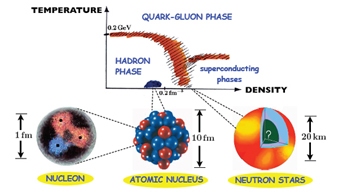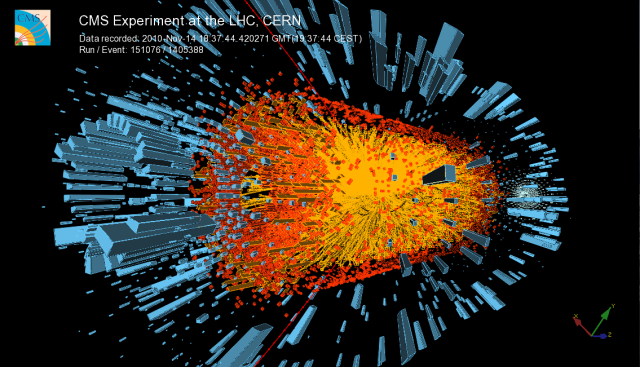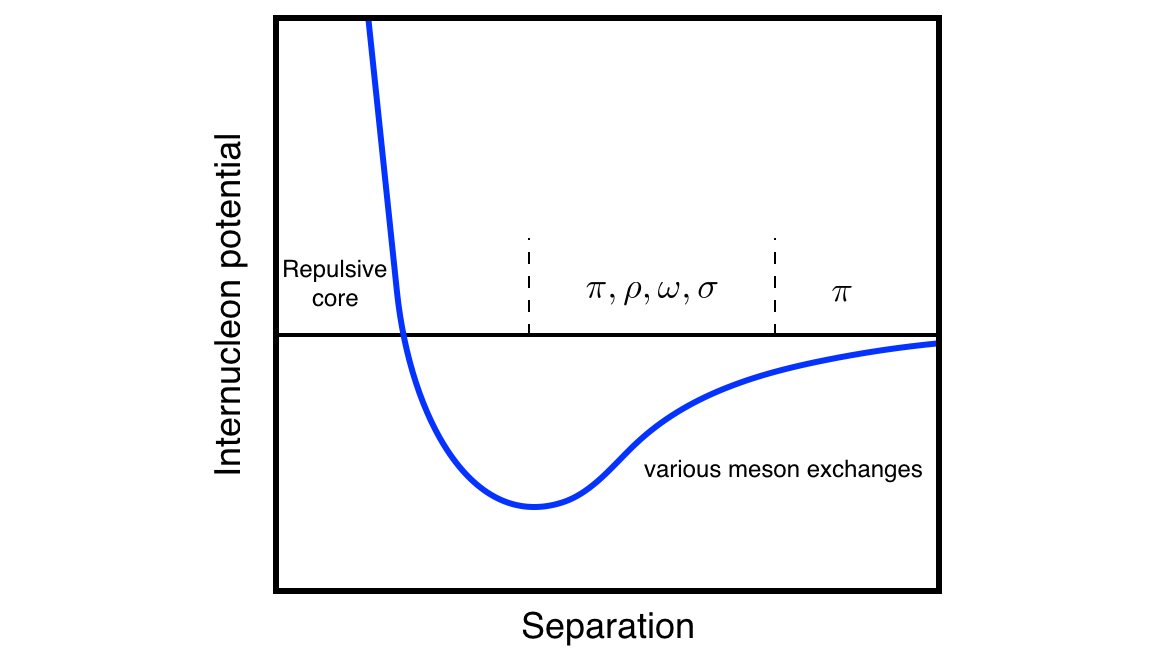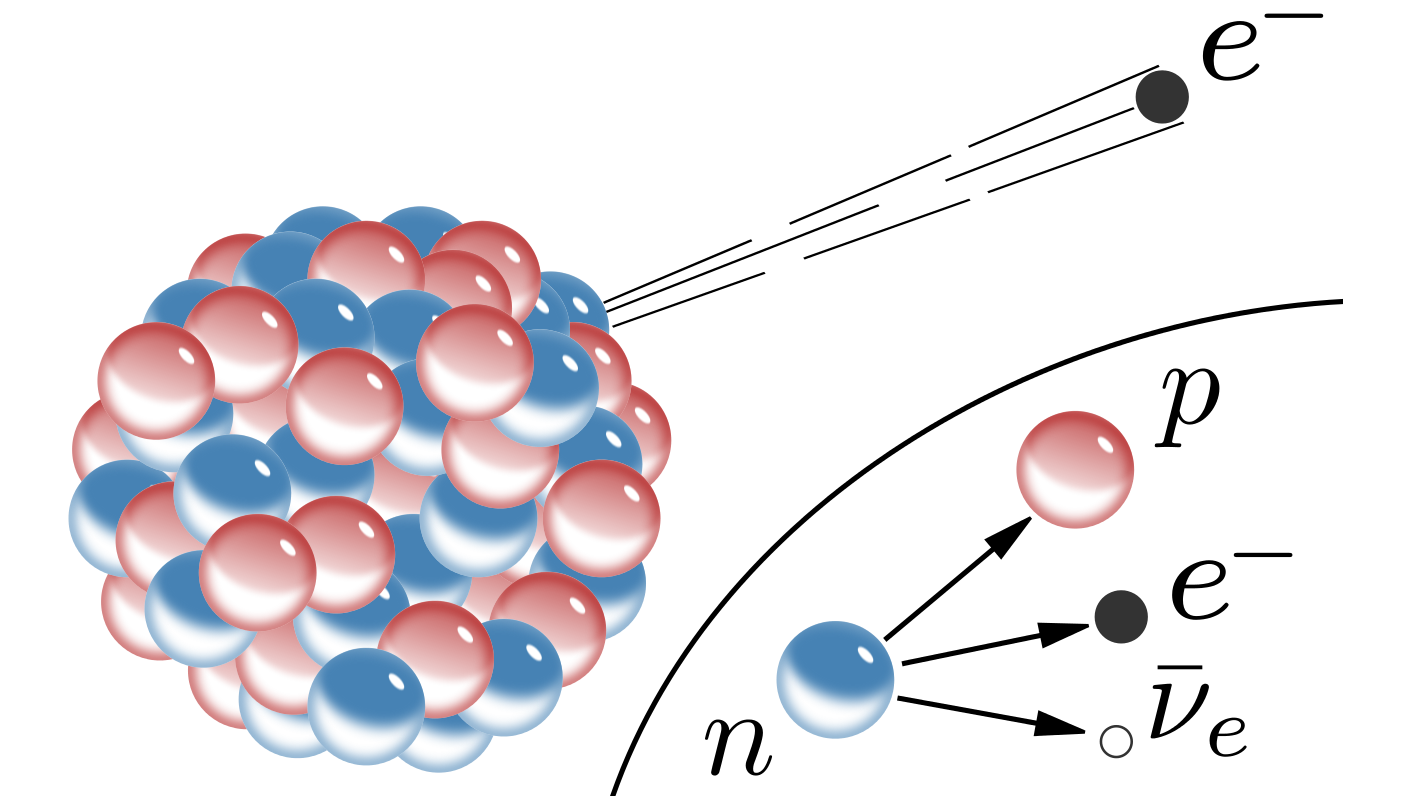Nuclear and Particle Physics
 Hadrons as protons and neutrons are composed out of quarks that interact by means of gluons.
Hadrons as protons and neutrons are composed out of quarks that interact by means of gluons. The strong interaction, known also
as quantum-chromo-dynamic (QCD), is mediated by the exchange of gluons. This force is responsible for the inner structure of
hadrons that are composed either by a quark-antiquark pair (mesons) or out of three quarks (baryons). The QCD is responsible
for the so-called confinement of the quarks within the hadrons and also for the fact that free-quarks are not realized in nature.
While it is possible to employ perturbative calculations to perform calculation in the high energy regime of QCD, in the low
energy regime which is relevant to describe the hadron properties, non-perturbative methods become necessary. In order to
extract with high precision the intrinsic properties of hadron and achieve a better understanding of the nature of the hadronic
interaction, several experimental and theoretical studies of this non-perturbative regime are currently carried out. For example
we want to understand how the spin of the proton results from the interplay of the spins and angular momenta of its constituents
and why the proton mass is about 1 geV/c2 whereas the masses of three quarks building up a proton sums up to only 15 MeV/c2.
Hadrons as protons and neutrons are composed out of quarks that interact by means of gluons.
Hadrons as protons and neutrons are composed out of quarks that interact by means of gluons. The strong interaction, known also
as quantum-chromo-dynamic (QCD), is mediated by the exchange of gluons. This force is responsible for the inner structure of
hadrons that are composed either by a quark-antiquark pair (mesons) or out of three quarks (baryons). The QCD is responsible
for the so-called confinement of the quarks within the hadrons and also for the fact that free-quarks are not realized in nature.
While it is possible to employ perturbative calculations to perform calculation in the high energy regime of QCD, in the low
energy regime which is relevant to describe the hadron properties, non-perturbative methods become necessary. In order to
extract with high precision the intrinsic properties of hadron and achieve a better understanding of the nature of the hadronic
interaction, several experimental and theoretical studies of this non-perturbative regime are currently carried out. For example
we want to understand how the spin of the proton results from the interplay of the spins and angular momenta of its constituents
and why the proton mass is about 1 geV/c2 whereas the masses of three quarks building up a proton sums up to only 15 MeV/c2.
 CMS collision events, candidate Upsilons in heavy-ion collisions. Photo: CERN
Before the universe cooled down to the point where hadrons could be built, a special phase of matter must have existed in which
quarks and gluons where not constrained within meson and baryons, the so-called Quark-Gluon Plasma (QGP). Huge theoretical and
experimental efforts have been initiated to discover and study this state of matter and especially to pin down the phase
transition between the QGP to hadronic matter. In this context, the study of hadronic matter produced under high temperature
and densities allows to pin down the properties of hadronic interactions and their interplay with the medium they are produced in.
CMS collision events, candidate Upsilons in heavy-ion collisions. Photo: CERN
Before the universe cooled down to the point where hadrons could be built, a special phase of matter must have existed in which
quarks and gluons where not constrained within meson and baryons, the so-called Quark-Gluon Plasma (QGP). Huge theoretical and
experimental efforts have been initiated to discover and study this state of matter and especially to pin down the phase
transition between the QGP to hadronic matter. In this context, the study of hadronic matter produced under high temperature
and densities allows to pin down the properties of hadronic interactions and their interplay with the medium they are produced in.
 Schematic diagram showing a typical internucleon potential. Various meson exchanges induce attractive interaction at long distances (~few fm), and there is a repulsive core at short distances (~1 fm) between nucleons. Photo: TUM.PH/Chung
Nucleons, neutrons and protons, are the lightest baryons and they are the building blocks of atomic nuclei. Because of the
substructure of the nucleons the interactions of free nucleons differs strongly from the interaction within nuclei. For this
reason, the properties of nuclei are described with the help of "effective interactions". The main goal of the low-energy
nuclear physics is to bring the understanding of nuclei up to a fundamental theory, such to fill the gap between QCD and the
effective nucleon-nucleon interaction. The goal of modern experiments in the field of nuclear physics is to understand all
the different components of this effective interaction. In order to reach this goal, one studies atomic nuclei produced under
extreme conditions as far as temperature, angular momentum and the proton-to-neutron ratio (isospin-dependency) is concerned.
Aside precision experiments at the MLL Tandem accelerator new short-living radioactive ion beams are employed, to study the
isospin-dependency of the interaction and the reactions that are relevant for astrophysical processes.
Schematic diagram showing a typical internucleon potential. Various meson exchanges induce attractive interaction at long distances (~few fm), and there is a repulsive core at short distances (~1 fm) between nucleons. Photo: TUM.PH/Chung
Nucleons, neutrons and protons, are the lightest baryons and they are the building blocks of atomic nuclei. Because of the
substructure of the nucleons the interactions of free nucleons differs strongly from the interaction within nuclei. For this
reason, the properties of nuclei are described with the help of "effective interactions". The main goal of the low-energy
nuclear physics is to bring the understanding of nuclei up to a fundamental theory, such to fill the gap between QCD and the
effective nucleon-nucleon interaction. The goal of modern experiments in the field of nuclear physics is to understand all
the different components of this effective interaction. In order to reach this goal, one studies atomic nuclei produced under
extreme conditions as far as temperature, angular momentum and the proton-to-neutron ratio (isospin-dependency) is concerned.
Aside precision experiments at the MLL Tandem accelerator new short-living radioactive ion beams are employed, to study the
isospin-dependency of the interaction and the reactions that are relevant for astrophysical processes.
 Weak nuclear interaction / beta decay
Beside the strong interaction, also the weak interaction is important to understand the nuclear properties. Indeed, the weak
interaction is responsible for the Beta-decay of radioactive nuclei, as for example the decay of free nucleons. Together with
the nuclear reactions it determines the time evolution of the burning processes within stars as e.g. in the sun, and is
fundamental in the synthesis of element that compose our world. Many of the nuclear reaction and nuclear properties that
play a key role in the understanding of processes in astrophysics can be nowadays studied in the laboratory with stable beams.
Weak nuclear interaction / beta decay
Beside the strong interaction, also the weak interaction is important to understand the nuclear properties. Indeed, the weak
interaction is responsible for the Beta-decay of radioactive nuclei, as for example the decay of free nucleons. Together with
the nuclear reactions it determines the time evolution of the burning processes within stars as e.g. in the sun, and is
fundamental in the synthesis of element that compose our world. Many of the nuclear reaction and nuclear properties that
play a key role in the understanding of processes in astrophysics can be nowadays studied in the laboratory with stable beams.
Research groups: Arbeitsgruppen: Brambilla - Bishop - Fabbietti - Kaiser - Paul